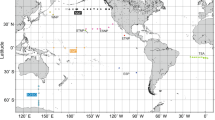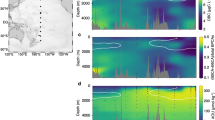Abstract
Water-soluble dicarboxylic acids (DCAs), ketoacids, and α-dicarbonyls in the marine aerosol samples collected over the Southern Ocean and western Pacific Ocean were determined. Oxalic acid was the most abundant species, followed by malonic acid and then succinic acid. It is suggested that aerosol concentrations of the organics over the Southern Ocean in this work represent their global background levels. Over the Southern Ocean, total concentrations of DCAs ranged from 2.9 to 7.2 ng m−3 (average: 4.5 ng m−3), ketoacids from 0.14 to 0.40 ng m−3 (av.: 0.28 ng m−3), and dicarbonyls from 0.06 to 0.29 ng m−3 (av.: 0.11 ng m−3). Over the western Pacific, total concentrations of DCAs ranged from 1.7 to 170 ng m−3 (av.: 60 ng m−3), ketoacids from 0.08 to 5.3 ng m−3 (av.: 1.8 ng m−3), and dicarbonyls from 0.03 to 4.6 ng m−3 (av.: 0.95 ng m−3). DCAs over the western Pacific have constituted a large fraction of organic aerosols with a mean DCAs-C/TC (total carbon) of 7.0% (range: 0.59–14%). Such a high value was in contrast to the low DCAs-C/TC (av.: 1.8%; range: 0.89–4.0%) for the Southern Ocean aerosols. Based on the relative abundances and latitudinal distributions of these organics, we propose that long-range atmospheric transport is more important over the western Pacific Ocean, in contrast, in situ photochemical production is more significant over the Southern Ocean although absolute concentrations of the organics are much lower.
Similar content being viewed by others
References
Ansari, A. S. and Pandis, S. N., 2000: Water adsorption by secondary organic aerosol and its effect on inorganic aerosol behaviour, Environ. Sci. Technol. 34, 71–77.
Baboukas, E. D., Kanakidou, and Mihalopoulos, N., 2000: Carboxylic acids in gas and particulate phase above the Atlantic Ocean, J. Geophys. Res. 105, 14,459–14,471.
Carlson, D. J., 1982: Surface microlayer phenolic enrichments indicate sea surface slicks, Nature 296, 426–429.
Chebbi, A. and Carlier, P., 1996: Carboxylic acids in the troposphere, occurrence, sources, and sinks: A review, Atmos. Environ. 30, 4233–4249.
Crahan, K. K., Hegg, D., Covert, D. S., and Jonsson, H., 2004: An exploration of aqueous oxalic acid production in the coastal marine atmosphere, Atmos. Environ. 38, 3757–3764.
Fine, P. M., Chakrabarti, B., Kudysz, M., Schauer, J. J., and Sioutas, C., 2004: Diurnal variations of individual organic compound constituents of ultrafine and accumulation mode particulate matter in the Los Angeles Basin, Environ. Sci. Technol. 38, 1296–1304.
Gao, S., Hegg, D. A., Hobbs, P. V., Kirchstetter, T. W., Magi, B. I., and Sadilek, M., 2003: Water-soluble organic components in aerosols associated with savanna fires in southern Africa: Identification, evolution, and distribution, J. Geophys. Res. 108, 8491, doi:10.1029/2002JD002324.
Graham, B., Mayol-Bracero, O. L., Guon, P., Roberts, G. C., Decesari, S., Facchini, M. C., Artaxo, P., Maenhaut, W., Koll, P., and Andreae, M. O., 2002: Water-soluble organic compounds in biomass burning aerosols over Amazonia 1. Characterization by NMR and GC-MS, J. Geophys. Res. 107, 8047, doi:10.1029/2001JD000336.
Grosjean, D., 1989: Organic acids in southern California air: Ambient concentrations, mobile source emissions, in situ formation and removal processes, Environ. Sci. Technol. 23, 1506–1514.
Hegg, D. A., Gao, S., and Jonsson, H., 2002: Measurements of selected dicarboxylic acids in marine cloud water, Atmos. Res., 62, 1–10.
Huang, S., Rahn, K. A., and Raimoto, R., 1999: Testing and optimizing two factor-analysis techniques on aerosol at Nattagansett, Rhode Island, Atmos. Environ. 33, 2169–2185.
Jang, M. and Mcdow, S. R., 1997: Products of benz[a]anthracene photodegradation in the presence of known organic constituents of atmospheric aerosols, Environ. Sci. Technol. 31, 1046–1053.
Jonsson, S., Ejlertsson, J., and Svensson, B. H., 2003: Behaviour of mono- and diesters of o-phathalic acid in leachates released during digestion of municipal solid waste under landfill conditions, Adv. Environ. Res. 7, 429–440.
Kawamura, K., 1993: Identification of C2-C10 ω-oxocarboxylic acids, pyruvic acid C2-C3 α-dicarbonyls in wet precipitation and aerosol samples by capillary GC and GC-MS, Anal. Chem. 65, 3505–3511.
Kawamura, K. and Gagosian, R. B., 1987: Implications of ω-oxocarboxylic acids in the remote marine atmosphere for photo-oxidation of unsaturated fatty acids, Nature 325, 330–332.
Kawamura, K. and Ikushima, K., 1993: Seasonal change in the distribution of dicarboxylic acids in the urban atmosphere, Environ. Sci. Technol. 27, 2227–2235.
Kawamura, K. and Kaplan, I. R., 1987: Motor exhaust emissions as a primary source for dicarboxylic acids in Los Angeles ambient air, Environ. Sci. Technol. 21, 105–110.
Kawamura, K., Kasukabe, H., and Barrie, L. A., 1996a: Source and reaction pathways of dicarboxylic acids, ketoacids and dicarbonyls in Arctic aerosols: One year of observations, Atmos. Environ. 30, 1709–1722.
Kawamura, K., Kobayashi, M., Tsubonuma, N., Mochida, M., Watanabe, T., and Lee, M., 2004: Organic and inorganic compositions of marine aerosols from East Asia: Seasonal variations of water-soluble dicarboxylic acids, major ions, total carbon and nitrogen, and stable C and N isotopic composition, in R. J. Hill, J. Leventhal, Z. Aizenshtat, M. J. Baedecker, G. Glaypool, R. Eganhouse, M. Goldhaber, and K. Peters (eds.), Geochemical Investigation in Earth and Space Science: A Tribute to Issac R. Kaplan, The Geochemical Society, Publications Series No. 9, Elsevier, pp. 243–265.
Kawamura, K. and Sakaguchi, F., 1999: Molecular distribution of water soluble dicarboxylic acids in marine aerosols over the Pacific Ocean including tropics, J. Geophys. Res. 104, 3501–3509.
Kawamura, K., Sempéré, R., Imai, Y., Jujii, Y., and Hayashi, M., 1996b: Water soluble dicarboxylic acids and related compounds in Antarctic aerosols, J. Geophys. Res. 101, 18,721–18,728.
Kawamura, K., Umemoto, N., Mochida, M., Bertram, T., Howell, S., and Huebert, B. J., 2003: Water-soluble dicarboxylic acids in the tropospheric aerosols collected over east Asia and western North Pacific by ACE-Asia C-130 aircraft, J. Geophys. Res. 108, 8639, doi:10.1029/2002JD003256.
Kawamura, K. and Usukura, K., 1993: Distributions of low molecular weight dicarboxylic acids in the North Pacific aerosol samples, J. Oceanogr. 49, 271–283.
Kerminen, V.-M., Ojanen, C., Pakkanen, T., Hillamo, R., Aurela, M., and Merilainen, J., 2000: Low-molecular-weight dicarboxylic acids in an urban and rural atmosphere, J. Aerosol Sci. 31, 349–362.
Limbeck, A. and Puxbaum, H., 1999: Organic acids in continental background aerosols, Atmos. Environ. 33, 1847–1852.
Limbeck, A., Puxbaum, H., Otter, L., and Scholes, M. C., 2001: Semivolatile behavior of dicarboxylic acids and other polar organic species at a rural background site (Nylsvley, RSA), Atmos. Environ. 35, 1853–1862.
Marttinen, S. K., Kettunen, R. H., and Rintala, J. A., 2003: Occurrence and removal of organic pollutants in sewages and landfill leachates, Sci. Total Environ. 301, 1–12.
Marty, J. C., Saliot, A., Buat-Menard, P., Chesselet, R., and Hunter, R. A., 1979: Relationship between the lipid composition of marine aerosols, the sea surface microlayers, and subsurface water, J. Geophys. Res. 84, 5707–5716.
Mayol-Bracero, O. L., Guyon, P., Graham, B., Roberts, G., Decesari, M. O. A. S., Facchini, M. C., Fuzzi, S., and Artaxo, P., 2002: Water-soluble organic compounds in biomass burning aerosols over Amazonia 2. Apportionment of the chemical composition and importance of the polyacidic fraction, J. Geophys. Res. 107, 8091, doi:10.1029/2001JD000522.
Mochida, M., Kawabata, A., and Kawamura, K., 2003a: Seasonal variation and origins of dicarboxylic acids in the marine atmosphere over the western North Pacific, J. Geophys. Res. 108, 4193, doi:10.1029/2002JD002355.
Mochida, M., Kawamura, K., Umemoto, N., Kobayashi, M., Matsunaga, S., Lim, H.-J., Turpin, B. J., Bates, T. S., and Simoneit, B. R. T., 2003b: Spatial distributions of oxygenated organic compounds (dicarboxylic acids, fatty acids, and levoglucosan) in marine aerosols over the western Pacific and off the coast of East Asia: Continental outflow of organic aerosols during the ACE-Asia campaign, J. Geophys. Res. 108, 8638, doi:10.1029/2002JD003249.
Munger, J. W., Jacob, D. J., Daube, B. C., Horowitz, L. W., Keene, W. C., and Heikes, B. G., 1995: Formaldehyde, gloxal, and methylglyoxal in air and cloudwater at a rural mountain site in central Virginia, J. Geophys. Res. 100, 9325–9333.
Narukawa, M., Kawamura, K., Okada, K., Zaizen, Y., and Makino, Y., 2003: Aircraft measurement of dicarboxylic acids in the free tropospheric aerosols over the western to central North Pacific, Tellus 55B, 777–786.
Narukawa, M., Kawamura, K., Takeuchi, N., and Nakajima, T., 1999: Distribution of dicarboxylic acids and carbon isotopic compositions in aerosols from 1997 Indonesian forest fires, Geophys. Res. Lett. 26, 3101–3104.
Neusüß, C., Gnauk, T., Plewka, A., Herrmann, H., and Quinn, P. K., 2002: Carbonaceous aerosol over the Indian Ocean: OC/EC fractions and selected specifications from size-segregated onboard samples, J. Geophys. Res. 107, 8031, doi:10.1029/2001JD000327.
Paatero, P. and Hopke, P. K., 2003: Discarding or downweighting high-noise variables in factor analytical models, Anal. Chim. Acta 490, 277–289.
Satsumabayashi, H., Kurita, H., Yokouchi, Y., and Ueda, H., 1990: Photochemical formation of particulate dicarboxylic acids under long-range transport in central Japan, Atmos. Environ. 24A, 1443–1450.
Saxena, P. and Hildemann, L. M., 1996: Water-soluble organics in atmospheric particles: A critical review of the literature and application of thermodynamics to identify candidate compounds, J. Atmos. Chem. 24, 57–109.
Saxena, P., Hildmann, L. M., McMurry, P. H., and Seinfeld, J. H., 1995: Organics alter hygroscopic behavior of atmospheric particles, J. Geophys. Res. 100, 18,755–18,770.
Seinfeld, J. H. and Pandis, S., 1998: Atmospheric Chemistry and Physics, from Air Pollution to Climate Change, Wiley, New York.
Sempéré, R. and Kawamura, K., 1994: Comparative distributions of dicarboxylic acids and related polar compounds in snow, rain and aerosols from urban atmosphere, Atmos. Environ. 28, 449–459.
Sempéré, R. and Kawamura, K., 1996: Low molecular weight dicarboxylic acids and related polar compounds in the remote marine rain samples collected from western Pacific, Atmos. Environ. 30, 1609–1619.
Sempéré, R. and Kawamura, K., 2003: Trans-hemispheric contribution of C2–C10 α,ω-dicarboxylic acids, and related polar compounds to water-soluble organic carbon in the western Pacific aerosols in relation to photochemical oxidation reactions, Global Biogeochem. Cycles 17, 1069, doi:10.1029/2002GB001980.
Stephanou, E. G. and Stratigakis, N., 1993: Oxocarboxylic and α,ω-dicarboxylic acids: Photooxidation products of biogenic unsaturated fatty acids present in urban aerosols, Environ. Sci. Technol. 27, 1403–1407.
Warneck, P., 2003: In-cloud chemistry opens pathway to the formation of oxalic acid in the marine atmosphere, Atmos. Environ. 37, 2423–2427.
Author information
Authors and Affiliations
Corresponding author
Rights and permissions
About this article
Cite this article
Wang, H., Kawamura, K. & Yamazaki, K. Water-Soluble dicarboxylic acids, ketoacids and dicarbonyls in the atmospheric aerosols over the southern ocean and western pacific ocean. J Atmos Chem 53, 43–61 (2006). https://doi.org/10.1007/s10874-006-1479-4
Received:
Accepted:
Issue Date:
DOI: https://doi.org/10.1007/s10874-006-1479-4




